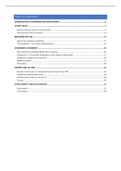TABLE OF CONTENTS
INTRODUCTION TO LEADERSHIP AND DEVELOPMENT .................................................................................... 2
LEADER TRAITS .............................................................................................................................................. 5
INTRODUCTION AND HISTORY OF TRAIT RESEARCH .......................................................................................................... 5
TRAITS ASSOCIATED WITH LEADERSHIP ......................................................................................................................... 6
BEHAVIORS & STYLES ................................................................................................................................... 11
BEHAVIOURAL THEORIES OF LEADERSHIP .................................................................................................................... 11
“NEW LEADERSHIP” – FULL RANGE LEADERSHIP MODEL ................................................................................................. 12
CHARISMATIC LEADERSHIP .......................................................................................................................... 16
EARLY WRITINGS ON CHARISMA (WEBER, HOUSE, SHAMIR) .......................................................................................... 16
CHARISMA AS A “VALUES-BASED, EMOTIONALLY-LADEN, SYMBOLIC LEADER SIGNAL” .......................................................... 17
CHARISMATIC LEADERSHIP TACTICS (CLTS) ................................................................................................................. 18
EMPIRICAL EVIDENCE ............................................................................................................................................. 21
CONCLUSION........................................................................................................................................................ 22
CONTEXT AND CULTURE .............................................................................................................................. 24
HISTORICAL APPROACHES TO CONTEXT (CONTINGENCY, SUBSTITUTES, SLT) ..................................................................... 24
LEADERSHIP CATEGORIZATION THEORY ...................................................................................................................... 24
CONTEMPORARY APPROACHES TO CONTEXT ............................................................................................................... 26
CULTURE ............................................................................................................................................................. 28
SOCIAL IDENTITY AND FOLLOWERSHIP ........................................................................................................ 32
SOCIAL IDENTITY ................................................................................................................................................... 32
FOLLOWERSHIP ..................................................................................................................................................... 34
,INTRODUCTION TO LEADERSHIP AND DEVELOPMENT
Leadership = the process of influencing other(s) towards the realization of a shared goal
(Antonakis & Day, 2017; Bastardoz & Day, 2021)
è Leaders are individuals who have a differential influence on the initiation, direction,
and coordination of group activities over and above the influence associated with
formal authority
è Leadership is about the interaction between a leader and a follower, about having
influence and a shared goal
Are leaders born or made?
“Few abilities are inherited. The majority of the more important abilities are learned and
developed in interaction with others. This is especially true for such abilities as leadership.
There are no born leaders”
è There are certain characteristics that help you emerge as a leader
è Intelligence is the most important predictor of leadership emergence and
effectiveness
What we know about leadership
- Leadership is a dynamic influential process, not a position or a static label
- Everyone exercises some form of leadership
- Leadership can be developed
- The effective leader behaviors/ styles are context-specific
o Depends on followers, environment, culture...
- Women and men are equally effective as leaders
- Many leadership practices are universal and some are culturally-specific
- Being a leader contains certain pitfalls (e.g., power)
o Sense of power tends to change your behaviour and cognitions
è There is no right or wrong leadership theory (succes depends on context)
Leadership training versus development
Training Development
Focus on knowledges, skills & attitudes Focus on behaviours, identity & self-views
Short-term (days, weeks) Long-term (months, years)
Highly structured Unstructured & varied
“Compared with relatively straightforward skills acquisition through training interventions,
leadership developmental initiatives take on more complex and holistic challenges
associated with changing the inherent behavioral tendencies of human beings”
è In training you can’t change one’s identity, behaviour and self-views
è There is a need to contrast skills and abilities to your identity and behaviours, which
is time consuming
,Leader development
Individual development:
- Across the entire lifespan (life long learning)
- All individuals do not experience or benefit in the same ways from the same
experience
- Leaders develop following different growth patterns
Informal rule of “70-20-10”
- 70%: Challenging assignments
o E.g. job transitions, unfamiliar responsibilities, facing obstacles
- 20%: Developmental relationships
o E.g. coaching, mentoring, feedback programs
è Be proactive in feedback seeking
- 10%: Coursework and training
o E.g. reflection, personal development, “knowledge”
Mindful engagement model
You need to approach leadership development from a systematic approach è consists of 3
components = Mindful Engagement Model
Approach (1)
3 components:
1. Growth (vs. Fixed) mindset: you can grow as a leader and become better
2. Embrace a learning orientation
3. Set learning goals: “goals drive behaviors”
Sometimes learning new things will make
you perform less for a while, but
afterwards you will be better and more
effective. It takes time
, Action (2)
Identify the kinds of experiences YOU NEED to add to your leadership portfolio
Get out of your comfort zone by gaining some experience in leading through challenging
assignments
- Get unfamiliar responsibilities
- Create change
- Influence without authority
- Working across culture/boundaries
- Manage diversity
Reflection (3)
Capture the lessons of experience and make sense of what happened and why.
è Experience is important, however you need to reflect on your experience afterwards
(what went well, what went bad)
For specific events, conduct an “after-events review” or debriefing
- Describe factually the experience
- Consider counterfactuals (i.e., “what-if” scenarios)
- Gather lessons learned and distill new insights
Hearing feedback
“Throughout your career, you're going to hear lots of feedback from show-makers and peers
and employees and bosses. If you hear a certain piece of feedback consistently and you
don't agree with it, it doesn't matter what you think. Truth is, you're being perceived that way"
è Hearing feedback is critical, especially when something is mentioned several times
Challenge & Support
“All development boils down to striking an appropriate balance between two fundamental
ingredients: challenge and support”
You need to find a balance
between finding the right challenge
and the support you receive
Toolbox – knowledge creation
a) Leadership is an influential process, not a position. Without followers, there are no
leader.
b) Embracing a "mindful approach" will help you approach your leadership development
rigorously.
c) Challenging experiences, a learning orientation, feedback and support are critical
aspects to develop and grow as a leader/human being.




